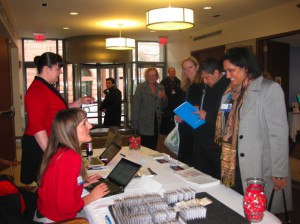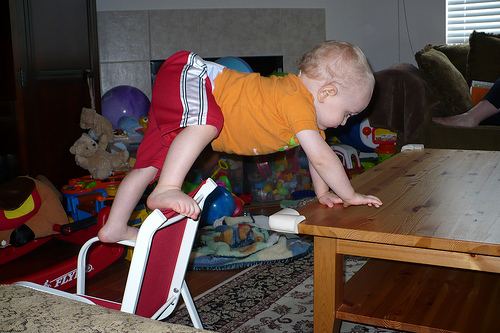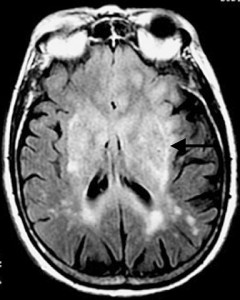On Tuesday, Children’s Hospital Boston featured its first Innovation Day. Organized by the Hospital’s Innovation Acceleration Program, which seeks to promote grass roots innovation within the hospital, the TEDMED style conference featured talks by 17 of the Hospital’s clinicians. Our Chief Innovation Officer Naomi Fried welcomed a packed house, which included attendees from across the country. Here we’re featuring some of the technologies that were revealed on Tuesday and how they’re changing the face of pediatric medicine: Full story »
Related posts:
Related posts:
- Making blood draws easier for children with autism
- When reading genes, read the instructions first: Epigenetics and developmental disorders
- Health care robots for the home: Why kids and parents prefer “embodied” robots
- Putting technology to work to get kids exercising
- Kids with cerebral palsy test the latest touchscreen technology
Just like today's pennies, our bodies have only a little bit of copper in them. But what we have, we need. Danielle Arsenault wants to understand how much copper is enough for children fed via an IV. (stevendepolo/Flickr)
Check the nutrition label on just about any packaged food, and you’ll see how much carbohydrate or salt, or how many calories, are lurking inside waiting for you. But that label won’t give you the whole nutritional picture. How much magnesium does your bag of chips contain? Or iodine, or copper?
These elements are all on the list of human micronutrients: nutrients that help maintain many of the critical biochemical processes within our cells. And while we only need them in very small amounts, micronutrient deficiencies can be devastating, even fatal.
Most of us get the micronutrients we need from our diet (chips aside), but for children whose digestive tracts can’t process regular food – such as those with intestinal disorders like short bowel syndrome (SBS) – getting the right amount of micronutrients is a different story. These children often often have to get all their nutrition intravenously through a process called parenteral nutrition (PN).
Since dieticians can tailor the nutrients given to a child on PN, you’d think that it would be easy to get the right amount of micronutrients, like copper, into the mix. But that isn’t necessarily so. Full story »
Related posts:
Related posts:
Related posts:
Related posts:
- Beating-heart surgery and the search for a killer app
- Newly approved Berlin Heart helps patients waiting for a transplant
- Could nanotechnology improve treatment of heart attack and heart failure?
- A phat cell-based technology for plastic surgery
- Building neurosurgical care in the heart of Africa: One doctor’s story
Related posts:
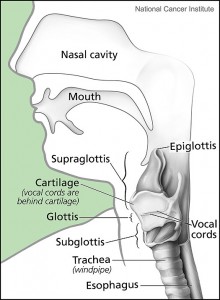
Anesthesiologists have to get by and around a lot of things in order to put a breathing tube into a surgery patient. Kai Matthes thinks that using a pair of endoscopes could make the job easier. (National Cancer Institute)
Intubating the patient is a critical step in any surgery where general anesthesia is being used. But as any anesthesiologist will tell you, intubating a child is very different from an adult, largely because there is less space available in which to maneuver the breathing (aka endotracheal) tube.
There’s also less space in which to see. To place a breathing tube properly and keep the airway open, an anesthesiologist needs to see the patient’s vocal chords and the opening of his or her windpipe. Typically, the doctor uses a laryngoscope to see into the throat, but sometimes tumors, congenital anomalies, inflammation, or other obstructions block the view.
The next tool of choice would be a fiber optic endoscope – essentially a long, thin, tubular video camera – to peer within the throat. Sometimes, however, even the fiber optic scope can’t get a full view, and on occasion the scope and tube can get in each other’s way, making the anesthesiologist’s job harder and the procedure riskier.
But here’s a thought: If one scope can’t do the trick, what about two? Full story »
Recent research on Type 1 diabetes has begun focusing on prevention: Studies indicate that children start developing diabetes-related autoantibodies sometimes years before they develop clinical diabetes requiring insulin shots. The autoantibodies are an indicator of insulitis – a precursor condition in which the insulin-producing islets in the pancreas become inflamed and infiltrated with white blood cells.
In animal models, immune-suppressing drugs have been shown to blunt this attack by curbing the number of white blood cells circulating in the body. That reduces the need for insulin treatment – but at a high cost: Given systemically, the high doses needed to suppress the immune attack cause kidney toxicity, reduce the ability to fight infections, and decrease the body’s ability to respond to insulin.
That’s a tough sell for a child who doesn’t yet have symptoms of diabetes – but that’s where nanotechnology can help, say researchers at the Wyss Institute for Biologically Inspired Engineering at Harvard University and Children’s Hospital Boston. What if immunosuppressants could be delivered in far smaller doses, just to where they’re needed in the pancreas? Full story »
Related posts:
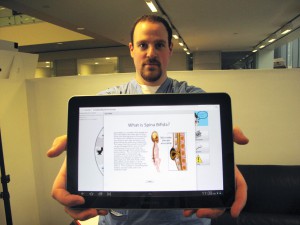
Brian Rosman holds up a tablet app he and a team of Children's and MIT Media Lab staff developed over the past two weeks during the Health and Wellness Hackathon
At 10 a.m. he’s directing two actors on set, at 10:34 a.m. he’s filling up a catheter and at 11:01 a.m. he’s gushing about the importance of pediatric avatars. Brian Rosman, a Robotic Surgery Research Fellow in the Department of Urology at Children’s Hospital Boston, has been working non-stop at the MIT Media Lab’s Health & Wellness hackathon to create a new app for post-operative care. His duties have included directing a video about the app, rounding up realistic props and explaining how the program works to judges and hackathon attendees.
Rosman and his team of coders, clinicians and industry professionals are competing against five other teams for a $10,000 prize awarded to the best open source healthcare application. Full story »
Related posts:

